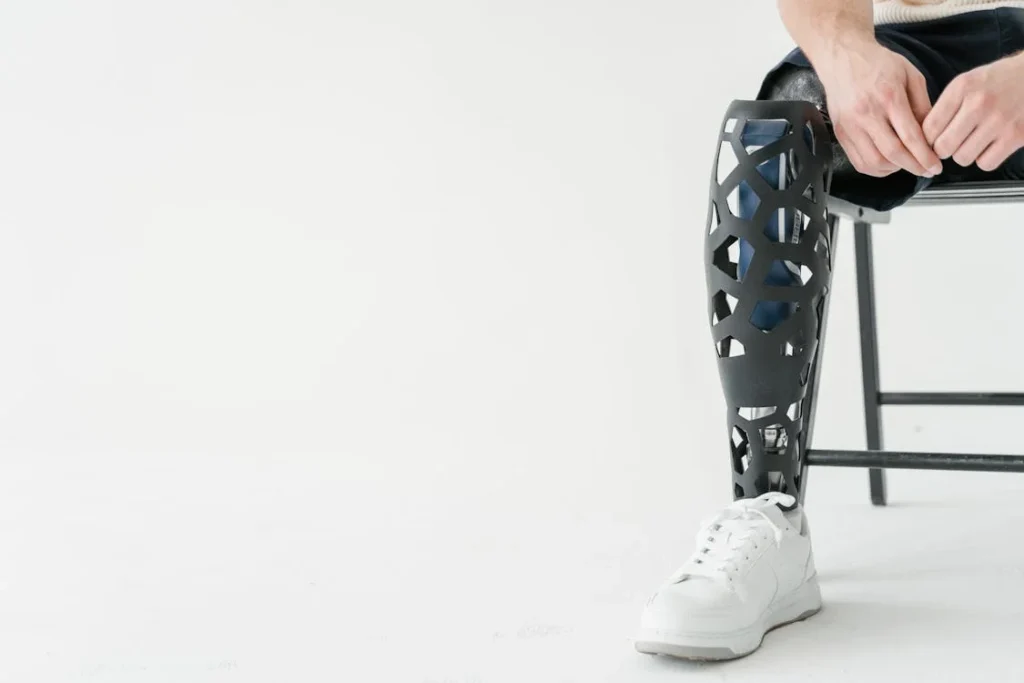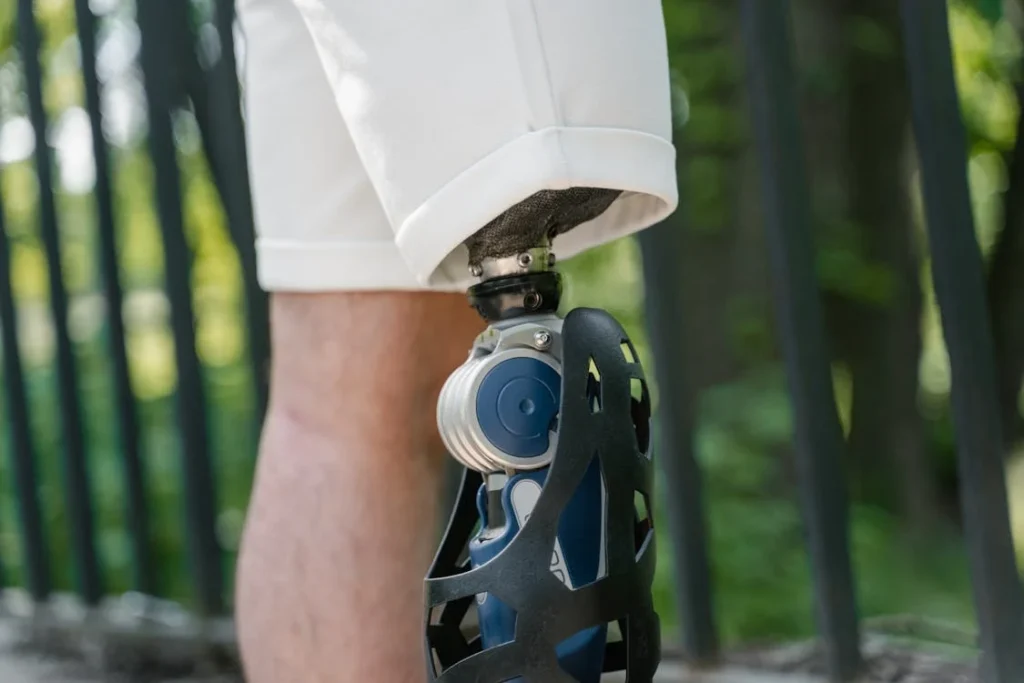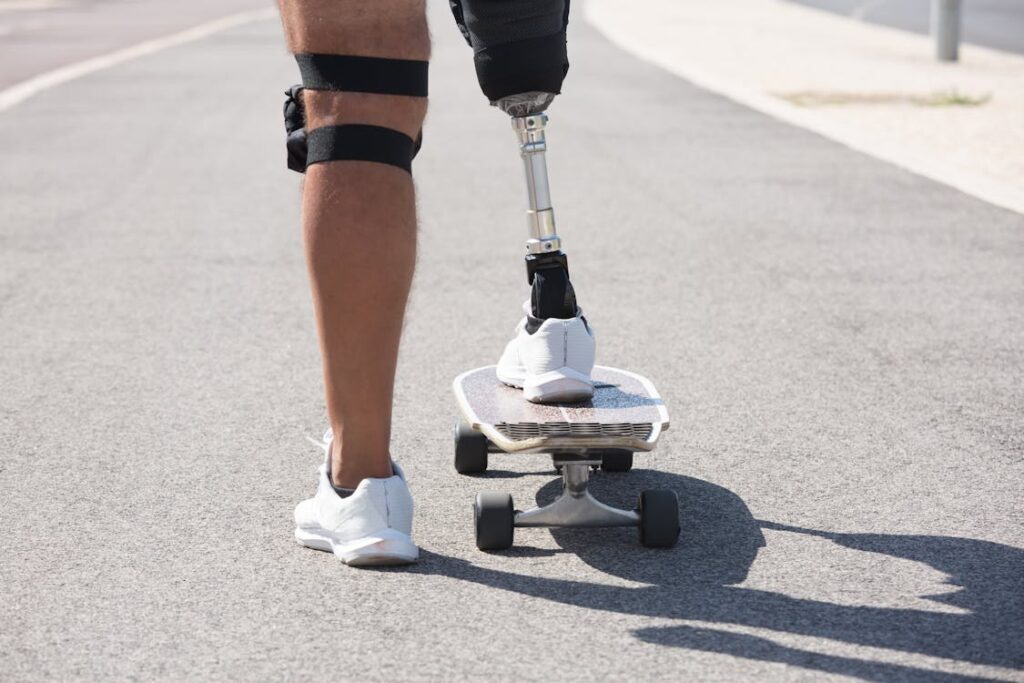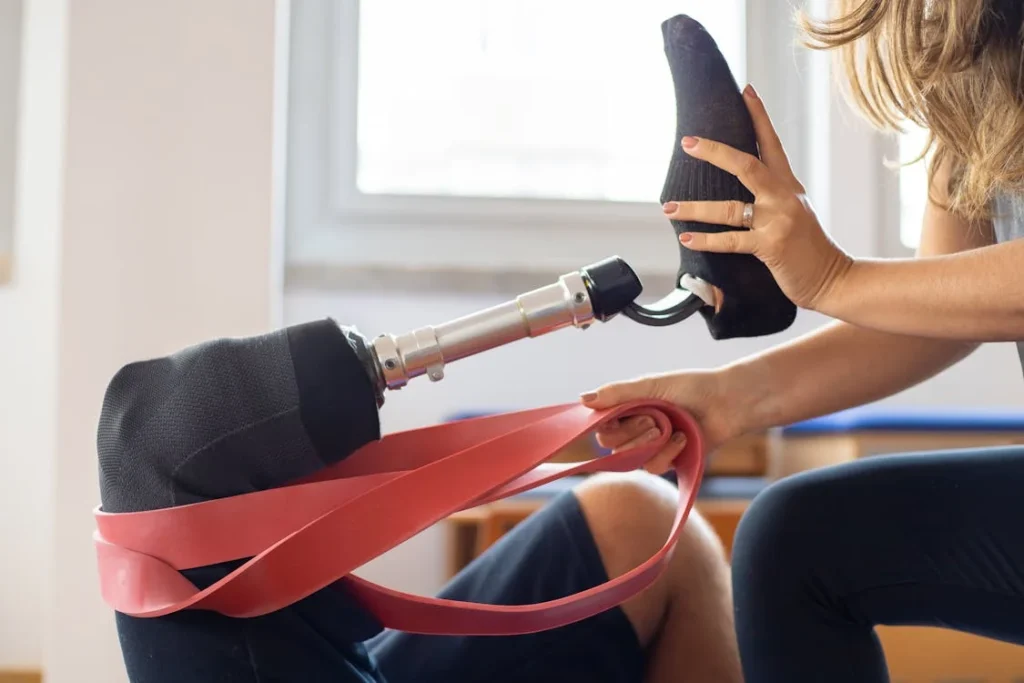The moment a person puts on a prosthetic limb, everything starts with the socket fit. It is the bridge between the body and the artificial limb. A good socket fit is not just about comfort. It affects how a person walks, how their weight shifts, how their muscles move, and how stable they feel throughout the day. And when the fit isn’t right, the body knows. There’s discomfort. There’s imbalance. There’s pain.
At Robobionics, we’ve worked with hundreds of users across India who come in thinking something is wrong with their limb—when the real issue is how the socket fits. That’s why we turn to biomechanics—the science of how the body moves—to understand, correct, and perfect each socket we make. Because behind every step taken with confidence is a socket that’s been designed with precision and care.

Understanding the Body–Socket Connection
The Foundation of Prosthetic Comfort and Movement
When a person loses a limb, what remains is a part of the body that is still full of nerves, muscles, bone, and skin. This part, called the residual limb, becomes the entire foundation on which the prosthetic limb will rest and function.
The socket wraps around this area, gripping it gently but firmly. It is not a simple connection. It’s a dynamic, constantly changing interaction that must be carefully managed.
Biomechanics looks at how forces move through the body. It helps us understand how weight is carried, how pressure is applied, and how the muscles, bones, and joints react to movement.
In the case of a prosthetic user, all those forces are funneled through a much smaller area than before—the socket. This makes fit incredibly important.
Every step the person takes, every shift in body weight, every time they sit, stand, or turn—all of it passes through the socket. If the fit is even slightly off, the forces are uneven.
And when forces are uneven, the body compensates. That leads to pain, fatigue, poor posture, and even long-term damage.
Pressure Distribution: A Balancing Act
Let’s look more closely at how pressure behaves inside the socket. The goal of a good fit is to spread the pressure evenly over the entire surface of the residual limb.
When this happens, the skin and tissue can tolerate the load, and movement feels natural. But when pressure collects in one small area—like under a bone or near a scar—it becomes painful.
This is where the science gets interesting. Different parts of the limb can handle pressure in different ways. Some areas, like the muscular parts, are better suited to bear weight.
Others, like bony edges or areas with thin skin, are more vulnerable. If too much force is placed on those sensitive spots, it leads to skin breakdown, bruising, or inflammation.
A well-designed socket uses biomechanical mapping to avoid these problem areas. At Robobionics, we assess the user’s limb carefully—checking for sharp bone edges, scar tissue, muscle density, and skin health.
Then we shape the socket to hug the stronger areas and avoid the weaker ones. We don’t just want the limb to fit inside the socket—we want it to feel like a part of the body.
Movement Inside the Socket: Why Stability Matters
When you walk with a biological limb, your muscles and joints move in harmony. The joints absorb shocks, and the muscles adjust tension to keep you balanced.
But with a prosthetic limb, there are no muscles or joints below the socket. All the movement and control have to come from the way the socket fits and how the residual limb interacts with it.
If the socket is loose, the limb moves inside it with each step. This is called pistoning—the up-and-down movement of the residual limb inside the socket.
Pistoning causes rubbing, instability, and poor control. It’s like wearing a shoe two sizes too big. On the other hand, if the socket is too tight, it can cut off circulation or press hard against sensitive areas.
Biomechanics teaches us how to find the sweet spot between tight and loose. The socket should grip the limb snugly without squeezing.
It should follow the shape of the limb but not trap it. And it should allow the residual limb to move with the prosthesis, not against it.
We use technology like pressure sensors and gait analysis to study how the socket performs during movement.
This gives us real-time data on where the forces are strongest, where the fit needs adjustment, and how to fine-tune the socket for optimal control.
Alignment and Load Transfer
Another critical part of socket biomechanics is alignment. The socket must line up correctly with the rest of the prosthetic limb to ensure that forces travel in a straight, stable path.
If the alignment is off—even by a few degrees—it can change how the body carries weight. This can throw off the user’s balance, strain their back or hips, or cause the foot to land in an awkward position.
Load transfer refers to how the body’s weight moves from the residual limb into the socket, then down through the prosthetic limb to the ground.
A good socket design ensures that this transfer is smooth and consistent. When it isn’t, you may notice uneven walking, sudden jerks during motion, or a tendency to lean to one side.
We often think of the socket as a passive part of the prosthesis, but it’s not. It’s a highly active player in how the body moves, absorbs shock, and maintains stability.
That’s why we never treat socket design as just a step in the fitting process. It’s the center of everything.

The Role of Soft Tissue and Muscle in Socket Fit
More Than Just Bone: Understanding Residual Limb Composition
When most people think of prosthetic fitting, they imagine a hard socket wrapping around bone. But the truth is, most of the residual limb isn’t made of bone. It’s made up of soft tissue—muscle, fat, skin, and connective layers.
These soft parts react very differently to pressure and movement than bone does. They shift, compress, and expand with every step, every twist, every seated position.
The biomechanics of socket fit must account for these living, moving tissues. Unlike a machine, the human body isn’t fixed. It changes throughout the day. Muscles swell after use.
Skin responds to temperature. Fluids shift with posture. So, a socket that fits perfectly in the morning may feel too tight or too loose by evening. This is especially common in India, where heat and humidity accelerate these shifts.
At Robobionics, we always look beyond the surface. We press gently into the limb to see how the tissues respond.
We study how much muscle is left, how soft or firm it is, how it moves under pressure. This helps us shape a socket that adapts—not just a static mold, but a form that respects the dynamic nature of the body.
Muscle Engagement and Residual Limb Control
One of the lesser-known aspects of prosthetic use is the continued use of muscles in the residual limb. Even without a full limb, the muscles near the end of the stump play a huge role in controlling the prosthesis.
They flex, shift, and stabilize the socket during walking. When the socket fit is good, these muscles stay active and strong. When the fit is poor, the muscles weaken over time because they don’t have anything to “push against.”
This is why some prosthetic users feel tired faster or develop poor posture. The socket doesn’t allow their muscles to engage naturally. Over time, this reduces strength, slows reaction times, and affects overall control.
Biomechanics gives us a clear insight into how to solve this. By studying muscle engagement patterns—using tools like surface EMG (electromyography) and motion capture—we can see where the limb is working and where it’s falling silent.
Then, we can reshape the socket to stimulate the right areas, giving the user more control and more natural movement.
We’ve seen this especially help active users—people who walk a lot, ride two-wheelers, or play sports. Once their socket starts supporting proper muscle use, they don’t just walk better. They feel stronger, faster, and more confident.
Socket Fit and Skin Movement
The skin is the body’s first line of defense, but in prosthetic use, it’s also one of the most affected parts. Poor socket fit leads to constant rubbing, especially during walking or long periods of standing.
This is called shear force—when the skin moves in one direction while the socket pushes in another.
Shear is different from pressure. You can press straight down on skin and it may tolerate it well. But sliding or shifting across the skin, even with low force, leads to redness, blistering, or deep wounds.
This is particularly dangerous for users with sensitive skin, recent surgeries, or health conditions like diabetes.
From a biomechanical perspective, the goal is to design a socket that minimizes shear. This is done by matching the internal contours of the socket closely to the natural curves of the limb.
Instead of having large flat areas that the limb can slide against, we create more intimate contact zones that move with the body, not against it.
Advanced liners can help too, but the core solution is always in the socket shape. We’ve seen users go from frequent skin breakdown to months of injury-free use simply because we reduced shear in key areas.

Dynamic Fit: Why Movement Matters More Than Sitting Still
Static Fit vs. Real-Life Fit
During the fitting process, many sockets are shaped and tested while the user is sitting or standing still. But life isn’t lived in stillness. People move.
They walk, bend, twist, climb stairs, ride buses, and carry weight. This is where dynamic fit becomes more important than static fit.
A socket that feels good while sitting might shift completely once the person begins to move. And this shift causes friction, pressure spikes, and reduced control.
That’s why at Robobionics, we never rely on static measurements alone. We make users walk, turn, and mimic real-life activities during socket trials.
We watch their gait closely. We ask how it feels—not just in the clinic, but after a full day of use.
Biomechanics gives us the tools to understand this better. Gait labs, pressure mapping, motion sensors—these all give clues about what the socket is doing during movement.
We take that data and make small changes: maybe the socket needs to be deeper here, or tighter there, or more flexible around this muscle.
These micro-adjustments are where science meets craftsmanship. They may take time, but they pay off in a big way: a socket that feels like a part of the user, not a tool they’re dragging around.

The Role of Suspension in Biomechanical Success
Why Socket Fit Alone Is Not Enough
Even the most perfectly shaped socket cannot perform well on its own. It needs a suspension system to hold it securely in place. Suspension is what connects the prosthetic limb to the user’s body.
It keeps the socket from slipping, lifting, or rotating during movement. Without proper suspension, even a great socket fit will fail in real-world use.
From a biomechanical point of view, suspension is essential for force transfer. When you walk, your body weight must move smoothly from your hips through your limb, into the socket, and finally down into the prosthetic foot.
If the suspension is loose, the forces don’t travel correctly. The limb might bounce, or there may be a delay between muscle movement and prosthetic response.
This throws off balance and timing, forcing the user to compensate with their other leg or their upper body. That’s how fatigue and injuries develop.
At Robobionics, we treat the suspension system as part of the socket, not as an afterthought. Whether it’s a suction system, pin lock, vacuum seal, or anatomical suspension, our goal is the same: stability without excess pressure.
When the suspension holds the socket in place without pulling or squeezing too hard, the biomechanical relationship remains smooth and natural.
How Suspension Affects Gait Mechanics
Every step a person takes involves a controlled sequence of movements. The leg swings forward, the heel strikes the ground, weight shifts onto the foot, and then the toe pushes off.
In a natural limb, this cycle is automatic. But in a prosthetic limb, the socket and suspension must guide every part of that motion.
If the suspension is too loose, the prosthetic limb lags behind. If it’s too tight, it restricts movement. In either case, the gait becomes uneven.
The user may begin to take shorter steps, limp slightly, or spend more time on their healthy limb. Over time, this throws the entire body out of balance—especially the spine and hips.
Biomechanics studies how these patterns develop. Using motion tracking and force plates, researchers can see how much time a person spends on each foot, how far they step, and how smoothly their center of gravity moves.
At Robobionics, we use these tools to adjust both socket shape and suspension strength. Sometimes, even a 1-millimeter change in fit or a slight tightening of the liner can bring the body back into balance.
The result isn’t just a better gait. It’s a smoother, more energy-efficient way of walking. And for users who wear their prosthesis all day, that energy savings makes a huge difference.

Load Tolerance and Long-Term Impact
What the Body Can—and Cannot—Handle
One of the key goals of good socket biomechanics is to protect the body from long-term harm. When weight and force move through the body in a balanced way, bones stay aligned, muscles work evenly, and joints move freely.
But when that balance is off, certain parts of the body are forced to work harder than others.
We often see this in the form of lower back pain, hip soreness, or knee strain—especially on the opposite side of the body from the prosthesis.
This happens when the socket doesn’t support the residual limb correctly. If the limb is being pushed too hard into the socket, or if it’s not aligned well with the ground, the body must twist or lean to stay upright.
Biomechanics helps us predict these problems. By studying how much force the body can tolerate and how that force moves through different tissues, we can adjust the socket to prevent overload.
For instance, we might use more flexible materials in certain areas to reduce stress, or deepen the socket around muscular areas to improve shock absorption.
This isn’t just about comfort today—it’s about preserving joint health and posture for the future. Many prosthetic users are young and active. They deserve a solution that keeps them strong and pain-free for decades.
Daily Wear and Tissue Response
The residual limb is not static. It responds to use, pressure, temperature, and movement. When a socket fits well, the skin and tissue inside adapt to daily wear without damage.
But when pressure points are too strong or poorly placed, the body responds with swelling, thickening of the skin, or inflammation.
This is why ongoing assessment is so important. What fits perfectly on the day of delivery may feel different a month later. The body changes.
Weight might be gained or lost. Muscle may build or reduce. The socket must be able to evolve with these changes.
At Robobionics, we always encourage users to return for follow-up checks—not just when something hurts, but as part of regular maintenance.
Using biomechanical tools like pressure mapping and gait analysis, we can detect small issues before they become big problems. This keeps the user comfortable and the socket performing at its best.
We also educate users on the signs of poor fit—skin redness that lasts more than 20 minutes, pain while walking, uneven shoe wear, or changes in posture.
These are signals from the body that something has shifted. With the right intervention, the socket can be adjusted, and balance can be restored.

Customisation and the Science of Individual Fit
Every Limb Is Unique
No two residual limbs are exactly alike. Even if two people have amputations at the same level, the shape, muscle structure, skin condition, and sensitivity of their limbs will differ.
This means that socket design cannot follow a single formula. It must be built from the ground up—for one person, one limb, one lifestyle.
Biomechanics supports this level of personalisation. It teaches us that comfort and performance come from aligning the prosthesis with the user’s exact anatomy and movement pattern.
A socket that works perfectly for one person could cause pain and dysfunction in another, simply because their body mechanics are different.
At Robobionics, our process always begins with a thorough evaluation. We don’t just measure limb length and width.
We observe how the person moves, how their muscles contract, where their skin is most sensitive, and what kind of activities they do every day.
We study the way they sit, how they shift weight when they walk, and where their natural center of balance lies.
This information becomes the blueprint for the socket. It tells us where to build in flexibility, where to add contour, and how to align the limb for both strength and efficiency.
Adjusting for Lifestyle and Environment
The science of socket biomechanics goes beyond anatomy. It also looks at the environment in which the user lives.
Someone who walks on city pavements faces different challenges than someone who farms in uneven fields.
A schoolteacher, a shopkeeper, a delivery worker, a mother running after a toddler—all have different movement patterns, postures, and load demands.
These lifestyle details inform how we design the socket. For instance, a user who climbs stairs frequently needs more knee control and shock absorption.
A user who walks long distances on hot roads needs better airflow and lighter materials. Someone with a physically active job needs a socket that holds firm under dynamic movements without causing skin damage.
Biomechanics allows us to think through these conditions carefully. It reminds us that function isn’t just measured in meters walked—it’s measured in how naturally a person can live their life without being held back by their prosthesis.
We don’t just want our users to walk. We want them to walk the way they want, go where they need, and do so with confidence, comfort, and pride.
Socket Fit for Growing and Changing Bodies
Biomechanics becomes even more important when designing sockets for people whose bodies are changing—such as children, adolescents, or adults undergoing rehabilitation or weight changes.
A child’s limb grows quickly. Their muscles strengthen, their bones lengthen, and their activity level shifts constantly. A socket that fits today might not fit two months later.
For these users, we design sockets with adjustability in mind. This may mean using modular liners, flexible panels, or quick-change suspension systems.
But the science still applies: each adjustment must preserve the core biomechanical principles—alignment, pressure distribution, stability, and control.
Adults who are building strength after surgery or recovering from injury also benefit from sockets that adapt to their body’s progress.
Their residual limb may become firmer, smaller, or more muscular. This means the socket must evolve with them—not resist their progress but support it.
By continually monitoring their biomechanics, we help users stay ahead of these changes. And when needed, we reshape or replace the socket to reflect their current body—not the one they had weeks or months before.

How Education and Communication Enhance Biomechanical Outcomes
Involving the User in the Process
One of the most powerful tools in biomechanical socket fitting is not a scanner, sensor, or algorithm. It’s a conversation.
When users are actively involved in describing their pain, their goals, and their daily routine, the quality of the socket fit improves dramatically.
Biomechanics is about how the body behaves under real forces. And nobody understands those forces better than the person living with them.
A user who says, “It only hurts when I climb stairs,” or “I feel like the limb lags behind me when I walk fast,” is giving biomechanical feedback. It may not sound technical, but it’s incredibly valuable.
At Robobionics, we teach users how to understand their own body mechanics. We explain what signs to look for—where their skin should not be red, how their walk should feel, when to ask for a socket check.
This turns the user from a passive recipient into an active partner. It also helps us create a better fit, faster, and with fewer adjustments.
This kind of collaboration is where true progress happens. It’s not just a science—it’s a relationship between user and maker, grounded in trust, care, and shared goals.
Conclusion
The biomechanics of socket fit isn’t just about measurements or materials—it’s about understanding how the human body moves, reacts, and adapts. A well-fitted socket becomes more than a support system; it becomes part of the person. It allows for freedom, comfort, and control. It protects the body from harm and gives users the confidence to walk, work, and live without hesitation.
At Robobionics, we believe that science and empathy must go hand in hand. That’s why we use biomechanical insights not just to shape sockets, but to shape lives. We listen closely, observe carefully, and build every socket as a unique response to the person who will wear it.
Because in the end, the true success of a prosthesis lies not in how it looks—but in how it feels, moves, and supports the human behind it. When science meets the real needs of real people, mobility is no longer a challenge—it becomes a joy.



